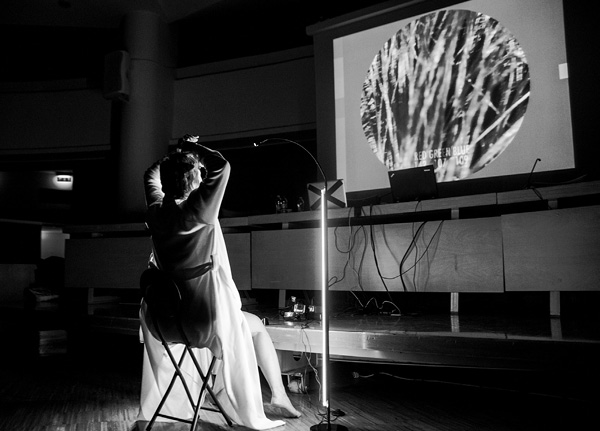
TONI / DI PELLE (SKIN / TONES)
first performed on December 15, 2016
ROMA 3, University of Rome, Rome, Italy
performed once in 2016
FRANCESCA FINI
Rome, Italy
026943624m026943624a026943624i026943624l026943624@026943624f026943624r026943624a026943624n026943624c026943624e026943624s026943624c026943624a026943624f026943624i026943624n026943624i026943624.026943624c026943624o026943624m
francescafini.com
TONI / DI PELLE (SKIN / TONES)
FRANCESCA FINI
A landscape that always tells a different story, our skin, is scanned with a digital microscope, showing details that look like maps of unknown planets. An infinite variety of colors, textures, and shapes, patterns and imperfections—sometimes beautifully frightening—are transformed into digital information, producing live sounds and visuals in synergy with the random movement of my hand.
I’m naked in front of two neon lights, back to the audience so that only the outline of my body is visible. I pass a digital microscope over my body, scanning the different textures of my skin: hair, lips, tongue, and so forth. The custom software, created with Isadora, then calculates the average color of each segment of my skin, transforming the data flow into live sound and video: the different sounds and samplings blend and mix exactly according to the mix of red, green, and blue—the RGB code—that is recorded in real time by the microscope. The visuals projected in front of me are the result of the image coming from the microscope, processed into mesmerizing, kaleidoscopic renderings that turn even the smallest imperfection into live art. Scars, wounds, benign melanomas, wrinkles, and stretch marks become mandala, crystals, jewels.
I offer my back to the audience, absorbed as I am in observing, and getting lost in, the kaleidoscopic and hypnotic digital processing of my own skin. The audience has a voyeuristic role here; they watch not only only my body, but its macroscopic deformation, as in a sort of super-selfie.
The performance plays ironically on the concept of biometrics, the study of the system of variables that could allow reliable identification of individuals through fingerprint, retina, or iris recognition devices. It celebrates the chaos, the mistakes, and the unpredictability of individual identity. The color of the skin, analyzed by the microscope lens and processed by the digital flow, becomes an endless and unpredictable variety of green, red, and blue combinations, losing any possible connection to the narrow, separative Cartesian reality visible to the naked eye. Under the digital microscope, female and male bodies also lose their sexual identity.
“SKIN / TONES” is a visual and sound celebration of cellular life itself.